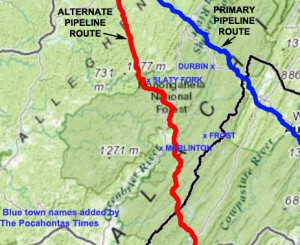Federal agency seeks alternate pipeline route through Monongahela National Forest
From an Article by Rick Steelhammer, Charleston Gazette-Mail, December 7, 2015
The Federal Energy Regulatory Commission has asked developers of the planned Atlantic Coast Pipeline to consider an alternative route through the Monongahela National Forest that would veer southward from the currently proposed route, to avoid environmentally sensitive areas, including the Cheat, Back Allegheny and Shenandoah mountains, and use existing utility right-of-way corridors whenever practicable.
The planned 42-inch-diameter, $5.1 billion, 564-mile pipeline would extend from Harrison County to southeastern North Carolina, carrying natural gas recovered from wells drilled into the Marcellus Shale formation in North Central West Virginia. About 17 miles of the Monongahela would be crossed before passing into Virginia.
The commission’s call for pipeline planners to “evaluate and optimize” the alternative route was part of a 168-item request for environmental information sent by the federal agency late last week in response to Atlantic’s 30,000-page application to build the pipeline, filed in September and accepted in October, setting an environmental review process in motion.
Among reasons cited by the commission for seeking an evaluation of the southerly alternative route was the potential for avoiding damaging and fragmenting habitat for rare plant and animal communities, crossing national recreation areas such as the Spruce Knob-Seneca Rocks National Recreation Area, and passing through areas being studied for possible wilderness status.
The commission’s request also made it clear that any route through the national forest must take into account the Monongahela’s long-range management plan in evaluating affected resources.
“Please note that we will not be able to consider construction and operation of any proposed action or alternative unless it complies with the National Forest’s LRMP, or Atlantic has documented that the U.S. Forest Service would amend a respective LRMP for activities deemed inconsistent with the LRMP,” wrote Kevin Bowman, environmental project manager for the commission, in the commission’s request for environmental information.
Bowman wrote that after commission officials consulted with Forest Service personnel and reviewed the Monongahela National Forest’s long-range management plan, “we have determined that alternative routes to the south of the currently proposed Atlantic Coast Pipeline route may offer environmental advantages over the currently proposed route.”
One alternative route in particular — MNF 5 — was cited by the commission for further study by pipeline planners. That route passes south of Cass and Snowshoe, crosses U.S. 219 one mile east of Slatyfork, skirts the northern slope of Cloverlick Mountain and crosses the Greenbrier River just north of Stony Bottom, before heading eastward through Dunmore and entering Virginia, 2.5 miles north of W.Va. 84. Pipeline mileage through the Monongahela National Forest is substantially reduced by following MNF 5, which initially was rejected over terrain challenges cited by pipeline developers.
The 168-item list requested by the commission is needed to “continue the draft Environmental Impact Study for the project,” Bowman wrote. “Please note that we will not be able to establish a schedule for completing the EIS until we have received your response and reviewed it for completeness.”
Environmental questions posed by the commission to pipeline planners that are not limited to national forest lands include estimated noise levels for compressor stations, and the effects the pipeline would have on any brook trout streams it crosses.
“It’s a very exciting development that FERC is concerned about impacts to one of the most ecologically sensitive sections of the Monongahela National Forest that is home to the protected West Virginia northern flying squirrel and the Cheat Mountain salamander,” said Judy Rodd, executive director of the Friends of Blackwater, part of a coalition of conservation groups monitoring the pipeline project. “It shows that FERC is paying attention to national forest issues and doesn’t want to make the national forests rewrite their management plans to accommodate the pipeline.”
The commission’s request for additional environmental information “is a very lengthy and substantive document,” said Aaron Ruby, a media relations manager with Dominion Resources, one of the partners in the Atlantic Coast Pipeline project, when asked to comment on the request. “We’re still in the process of reviewing it.”
See also: www.dom.com/corporate/what-we-do/atlantic-coast-pipeline

